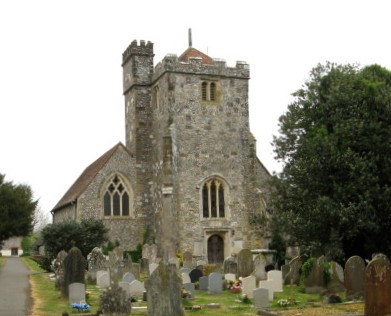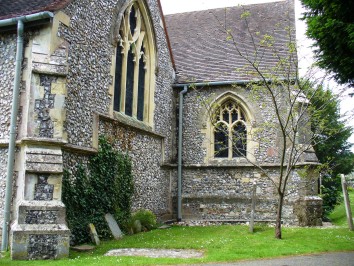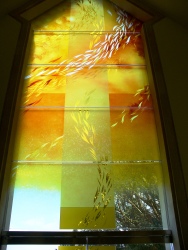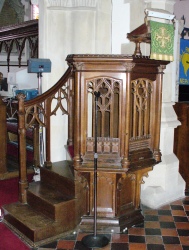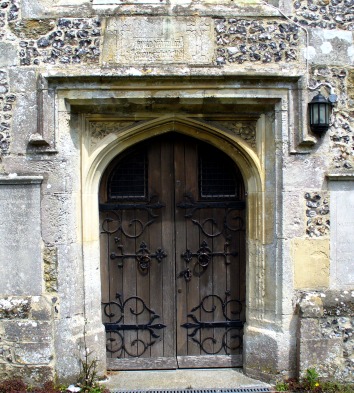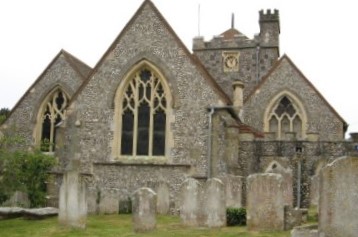Angmering – St Margaret
The mediaeval parish had three churches, of which only this survives. Originally late C12, only a few remnants and the tower of 1507 survived the rebuilding of 1852-53 by S S Teulon. The C19 carving is of high quality. The entire east end and the interior were remodelled in 2007-09.
The parish of Angmering was, until an ordinance of 1573 consolidated it (2 p18), effectively three, reflecting its manorial structure. The others were East Angmering (St Nicholas) and Bargham (or Barpham). East Angmering church was behind the school facing St Margaret’s and passed from the Earls of Arundel to the College of Arundel in the early C16 (3 p3). The VCH (5(2) p29) gives the date of 1573 for the uniting of the parishes, though Bedwin records an incumbent of East Angmering as late as 1593 (2 ibid), which is when the church was probably removed. Hussey recorded (p186) that ‘two shapeless fragments of wall’ were still to be seen that were thought to be part of this church. Excavations in 1974 revealed four phases of building, from the C11 to the C15 (see 2). The site is now a public garden.
A Downland field called Chapel Croft, well north of the centre of the parish, marks the site of Bargham church, of which nothing visible remains, though when Hussey visited in 1848 (p191), some foundations could be seen. Excavations (see 1) identified seven phases of construction, the earliest possibly pre-Christian. At its largest it included C11 transepts, but it was rebuilt smaller after a fire in the C14. The village was in decline by the Black Death, possibly because of sheep farming. The church is recorded as in ruins in 1650 (VCH 5(2) ibid) though the last rector had been instituted in 1521 (1 p21), shortly before Bishop Sherburne endowed a prebend in the cathedral from the emoluments and as late as the 1930s the tithe ascertainment for St Margaret excluded Bargham (TNA IR 104/67).
St Margaret’s is large and owes its character to S S Teulon‘s rebuilding in 1852-53 (B 9 p247), paid for by W K Gratwick, Lord of the Manor (Lower I p2). However, enough fragments and information about the mediaeval one remain to give some impression of its appearance. Thus, the chancel arch remains late C12, though much renewed. The triple shafted responds and stiff-leaf capitals indicate a church of some importance. Of the same date are the plain square responds of the arch from the south chapel into the aisle. Hussey (p187) records a ‘Transitional’ three-bay south arcade, which was probably also late C12. A reset doorway of this date in the present aisle has shafted responds and there may also be some old walling in the chancel.
In the C15, the south aisle was rebuilt, as a consequence of which it was wider than the nave. In addition, the south chapel was remodelled and most windows were replaced. The Sharpe Collection drawing (1805) shows the aisle under a roof that continued the line of the nave one. On the north side of the chancel are signs of a former chapel, particularly a blocked dooway, with C15 detail and the late C12 chancel may have been lengthened then, for both the Sharpe drawing and Adelaide Tracy (1851) (II p80) show a large east window with panelled tracery. If so, this would have accentuated the extent to which it was angled to the north, as was apparent before the rebuilding. The final addition before the Reformation was the tower of rough flint and stone chequerwork. An inscription dated 1507 records its construction by Syon Abbey, which had been granted the church after it was confiscated from the Norman abbey of Fécamp in the early C15. 1507 marks probably the start of construction, as there was a bequest for the work in 1516 (3 p6). Its four-centred west window and square-headed uncusped bell-openings are typical of the date, as is the tower arch with three orders on the head, the innermost one of which merges into the square responds without abaci. The heavy rectangular stair-turret is also battlemented, though Goodhart-Rendel (GRI) suggests it may have been altered.
The church underwent the vicissitudes common to so many in the C17 and C18. These included a west gallery and one in the south aisle of 1737, when repairs were also made to the nave and aisle roofs (VCH 5(2) p55), whilst the north chapel was removed in 1774 or 1775 (ibid); the blocked arch from the chancel was still visible in Hussey’s time (ibid). There is evidence of the galleries in the drawing by Holbrooke (1806) (WSRO Add MS 23938), which otherwise confirms that most external detail was C15. In 1837 a surveyor, G Harrison, reseated the church (ICBS), but does not appear to have altered the structure, though he produced valuable plans of the then church. In 1847 Sir Stephen Glynn noted that the entire south arcade had gone (SRS 101 p10) and it was left to Teulon to undertake the major work of reconstruction. He added a north aisle of similar dimensions to the south one, which was rebuilt with a replaced arcade and the addition of a porch. Externally, everything except the tower was refaced in flint and the windows were replaced with C14-style tracery. Both arcades were replaced and the new ones have big foliage capitals carved by J Forsyth, who also did the shafts supporting the roof and, probably, the blank arcading at the east end. The exuberant work at Angmering shows that, though Teulon was associated with the Low Church party, such churches need not be dull. Characteristic of the doctrinal position of the church are the painted texts of the Creed and Lord’s Prayer over the chancel arch (these were more commonly found as a reredos) and a now removed gallery in the north aisle, which was criticised by The Ecclesiologist (Dec 1857). Teulon took pains over the glass and fittings (some, like the pulpit, no longer there) and fitted out the south chapel to contain the memorials of the Gratwick family, adding a cusped rere-arch for the east window.
The only change in the C20 was the addition of a flat-roofed vestry and office to the north of the chancel. Most recently, plans to extend and re-order the church were announced in 2003, to designs by N A Lee-Evans (V July 2007 p8). After a lengthy hearing, in 2007 the Consistory Court agreed to these. The most obvious changes are the gabled extensions either side of the chancel. That to the south is built in front of the east end of the Gratwick chapel and forms the main entrance, whilst the north one replaces the C20 structure and is used as a parish office. Their east walls are largely glazed. Inside, the pews have been replaced by chairs arranged across nave and aisles in semi-circles, which are centred on a sunken baptistery. The pulpit of 1910 (VCH 5(2) p56) has been given away, but Teulon’s font, reading desk and lectern remain in the church. Work was completed in June 2009 and though there has been a significant loss to Teulon’s concept, the new three-gable view from the east provides some compensation.
Fittings and monuments
Brass: (By chancel arch) Eden Baker (d 1598). Small effigy wearing a tall hat.
Capital: C11 volute capital found at Bargham church.
Chest: Small mid-C16.
Font and font cover: Large carved bowl by Forsyth with a conical cover hanging from an elaborate iron bracket.
Glass:
1. (Main east and chancel side windows, east and south windows of south chapel) C A Gibbs, in collaboration with Teulon, 1853 (WSRO Par 6/4/1).
2. Two by Ward and Nixon 1853 (KI).
3. (South aisle) Three by Lavers, Barraud and Westlake, 1868, 1872 and 1888 (one signed, the others attr. on stylistic grounds – www.stainedglassrecords.org retrieved on 28/1/2013).
4. (Porch side-openings) Lavers, Barraud and Westlake, c1870 (NR-D).
5. (North window) W Drake, 1933 (L Horton) (NR-D).
6. (East windows of new side-extensions) Engraved and enamelled glass by M Howse, 2008 (CT 18 April 2008).
Lectern: Part of Teulon’s fittings, facing two ways, with an angel on a shaft at the angle.
Monuments: The Gratwick memorials are probably by Teulon and Forsyth.
Painting: A Doom was discovered over the chancel arch in 1852, but not preserved (SAC 38 (1892) p6). It was then ascribed to the C15.
Sources
1. A Barr-Hamilton: The Excavation of Bargham Church Site, SAC 99 (1961) pp38-65
2. O Bedwin: The Excavation of the Church of St Nicholas, Angmering, 1974, SAC 113 (1975) pp16-34
3. W H Godfrey: Guide to the Church of St Margaret, Angmering (Sussex Churches No 20), 1955
4. : The Parish Church of St Margaret, Angmering, SNQ 15 (May 1959) pp95-96
Plan
Measured plan by W H Godfrey in 3. inside front cover
Acknowledgements
1. My particular thanks are due to R W Standing, who drew my attention to articles about the church and parish by Neil Rogers-Davis (NR-D). These articles contain much invaluable information about the church both before and after the C19 rebuilding. I have not cited each reference, except for two attributions, as there would be so many, but they are essential to an understanding of the development of the church. Mr Standing (RS) has also made available most of the colour photographs of the church which in particular are a valuable record of its fittings before and after the recent work, particularly those of the interior.
2. My thanks also to Josie Campbell (JC), who provided the colour photo of the photo of the east end before the recent changes and also the tower from the west
